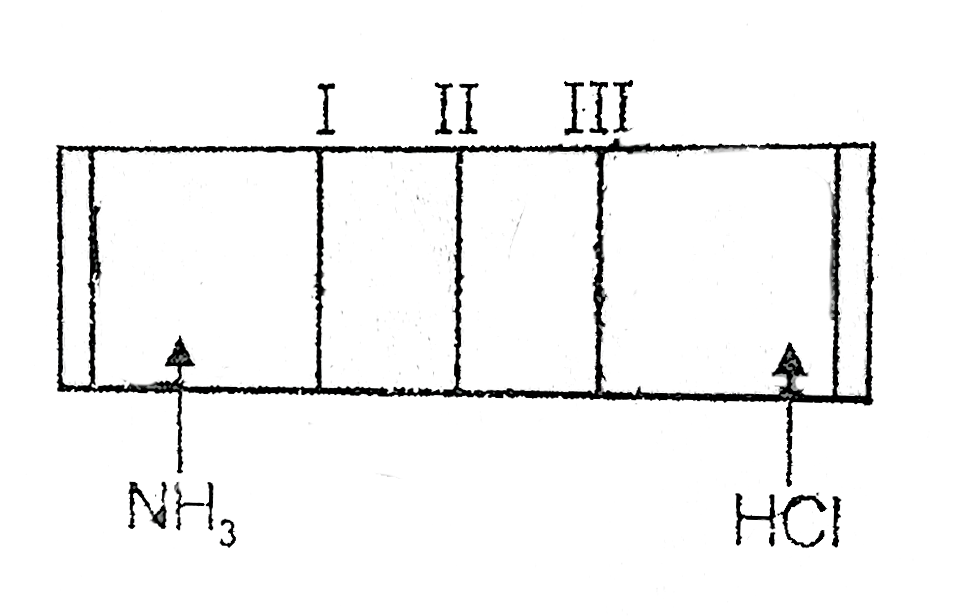When two cotton plugs, one moistened with ammonia and the other with hydrochloric acid, are sumulataneously inserted into opposite ends of a glass tube 87.0 cm long, a white ring of NH4Cl forms where gaseous NH3 and gaseous HCl first come into contact.
NH3(g)+HCl(g)→NH4Cl(s)
At what distance from the ammonis-moistened plug does this occur?
51.7 cm from NH3 end
51.7 cm from HCl end
43.5 at mid point
None of these
The correct Answer is:a
(a) rNH3rHCl=√36.517=x87.5−x

x=51.7cm
Topper's Solved these Questions
- BOOK - NARENDRA AWASTHICHAPTER - GASEOUS STATEEXERCISE - Level 1 (Q.31 To Q.60)1videos
GASEOUS STATE
- BOOK - NARENDRA AWASTHICHAPTER - GASEOUS STATEEXERCISE - Level 1 (Q.121 To Q.150)1videos
GASEOUS STATE
- BOOK - NARENDRA AWASTHICHAPTER - ELECTROCHEMISTRYEXERCISE - Level 3 - Subjective Problems1videos
ELECTROCHEMISTRY
- BOOK - NARENDRA AWASTHICHAPTER - IONIC EEQUILIBRIUMEXERCISE - Exercise196videos
IONIC EEQUILIBRIUM
Similar Questions
The reaction between gaseous NH3 and HBr produces a white solide NH4Br. Suppose a small quantity of gaseous NH3 and gaseous HBr are introduced simultaneously into opposite ends of an open tube which is one metre long. Calculate the distance of white solid formed from the end which was used to introduce NH3
View SolutionThe reaction between gaseous NH3 and HBr produces the white solid NH4Br. Suppose that NH3 and HBr are introduced simultaneously into the opposite ends of an open tube that is 1 metre long. Where would you expect the white solid to form ?
View Solution
Knowledge Check
- Question 1 - Select One
A bottle of dry NH3 and another bottle of dry HCl connected through a long tube are opened simultaneously at both ends of the tube. The white ring (NH4Cl) first formed will be
AAt the centre of the tubeBNear the HCl bottleCNear the ammonia bottleDThroughout the length of the tube - Question 2 - Select One
NH4Cl(s)→NH3(g)+HCl(g) when the above reaction occurs, the entropy
ARemains sameBDecreasesCIncreasesDNone of the above - Question 3 - Select One
Two pieces of cotton wool soaked separetely in aqueous solution of NH3 and HCl are placed at opposite ends of a close glass tube as shown in diagram

Select nearest position where white solid is formedAIBIICIIIDWhite solid does not formed
Two flasks A and B of equal volume containing NH3 and HCl gases, are connected by a narrow tube of negligible volume. The two gases were prevented from mixing by stopper fitted in connecting tube. For further details of the experiment, refer to the given figure. What will be final pressure (in mm of Hf) in each flask when passage connecting two tubes are opened, assuming ideal gas behaviour of NH3andHCl gas and the reaction
NH3(g)+HCl(g)→NH4Cl(s) goes to completion.
 View Solution
View SolutionAt room temperature, ammonia gas at 1 atm pressure and HCl gas at pressure P atm are allowed to effuse through idential pin holes from opposite ends of a glass tube of 1 meter length and of uniform area of cross-section. NH4Cl is first formed at a distance of 60 cm from the end through which HCl gas was sent in. Calculate the value of P.
View SolutionAt room temperature, NH3 gas at 1 atm and HCl gas at P atm are allowed to effuse through identical pinholes from oppoite ends of a glass tube of 1 metre length and uniform cross section. NH4Cl is first fomed at a distance of 60 cm from the end through whieh, HCI gas is sent in. What is the value of P?
View SolutionIn a 2 m long narrow tube, HCl is allowed to diffuse in the tube from one end and NH3 from the other end. If diffusion is started at the same time, predict at what point the white fumes of NH4Cl will form ?
View SolutionA 5.00L evacuated cylinder is charged with 25.5g of NH3 and 36.4 g of HCl. Calculate the final pressure at 85.0∘C after the two compounds have reacted completely:
NH3(g)+HCl(g)→NH4CI(s)View Solution

